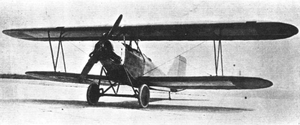Heinkel HD 32
The Heinkel HD 32 was a trainer developed in Germany in the 1920s, a derivative of the HD 21. Like that aircraft, it was a conventional, single-bay biplane, but had only two cockpits rather than the three that the HD 21 had. The other significant change was the use of a Siemens radial engine in place of the inline units that powered most of the HD 21 family.
| HD 32 | |
|---|---|
 | |
| Heinkel HD.32 at the 1925 Round Germany Contest | |
| Role | Trainer |
| National origin | Germany |
| Manufacturer | Heinkel |
| First flight | 1926 |
A number of HD 32s participated in the 1925 Deutscher Rundflug, including one powered by a Bristol Lucifer engine.
Specifications (variant)
General characteristics
- Crew: Two, pilot and instructor
- Length: 6.80 m (22 ft 4 in)
- Wingspan: 10.50 m (34 ft 5 in)
- Height: 3.02 m (9 ft 11 in)
- Wing area: 24.3 m2 (262 ft2)
- Empty weight: 520 kg (1,150 lb)
- Gross weight: 900 kg (1,980 lb)
- Powerplant: 1 × Siemens-Halske Sh 12, 93 kW (125 hp)
Performance
- Maximum speed: 140 km/h (88 mph)
- Range: 600 km (375 miles)
- Service ceiling: 3,800 m (12,500 ft)
- Rate of climb: 2.2 m/s (430 ft/min)
Armament
References
| Wikimedia Commons has media related to Heinkel HD 32. |
- Taylor, Michael J. H. (1989). Jane's Encyclopedia of Aviation. London: Studio Editions. p. 499.
This article is issued from Wikipedia. The text is licensed under Creative Commons - Attribution - Sharealike. Additional terms may apply for the media files.